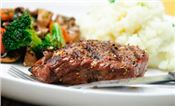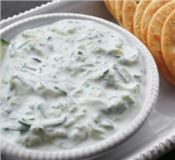Recipe Page
Grill A Steak For Dad On Fathers Day

Imagine dad's surprise when he sits down to a juicy grilled steak with all the fixings and he wasn't "king of the grill".
CARLA HALEY-HADLEY
TEXARKANA, ARKANSAS
It’s the one time of year when we take time to share how much we appreciate all the things dad has done for us, and the time he has given us. So why not take time to grill his favorite steak with all the trimmings.
Imagine his pleasure when he sits down to a juicy grilled steak with all the fixings, and he wasn’t “king of the grill” for the meal. But what if you have no clue where to even begin? Relax, help is here!
Here are some tips for giving dad a steak dinner he will love.
Remember, safety first with the grill and food. Make sure the grill rests securely on the ground, deck, patio, or other surface. Never leave the grill unattended and never use indoors or in a garage where the fumes cannot be vented. Always keep children and pets at safe distances.
When it comes to food safety, be sure to always pre-heat the grill to kill microorganisms before placing the steak on it. Always use separate clean tongs and plate when removing the steak from the grill. This will help to avoid cross contamination of bacteria with uncooked meat.
As with any cooking project, the right ingredients are essential.
Depending upon budget, decide which type of steak to purchase. Your more tender cuts of steak include rib eye, T-bone or porterhouse, sirloin or top loin strip. Because they are the tenderest, they will also be more expensive. Your less tender cuts, such as flank and top round will be easier on the budget. Give dad the best your budget can afford.
Although grilling will give you a juicy, smoky steak, sometimes you want to add a little flavor to the mix. Do so with rubs and marinades, both of which add flavor and tenderness to anything you put them on.
Rubs are dry spice blends which usually include salt and sugar. The advantage of a rub is that you can rub them on immediately before cooking, adding mild flavor; or do it a day or two in advance, bringing the spice flavor deeper inside the meat.
Marinades are liquid and usually contain something acidic such as lemon juice, vinegar, or yogurt or tropical fruit like papayas, pineapples or kiwi. Both acids and enzymes found in tropical fruit react with meat proteins to tenderize. To keep food from becoming over- tenderized, it's important not to marinate too long. The general rule of thumb is 15 minutes for seafood, four to six hours for thin cuts of meat, and up to 12 for larger ones.
A quick tip for marinades is to use a resealable plastic bag – put everything in, seal it and give a shake. Never reuse marinades. If you want to make a sauce out of the leftovers, either boil them for at least two minutes, or make a separate batch for sauce.
If you choose to marinate, thaw meat and marinate in the refrigerator, on a low shelf, on a plate to catch drips.
Understanding the difference between indirect and direct grilling and when to use each provides different results. Direct grilling means just that, you are placing the food directly over the flame; indirect means that the food is placed away from the heat source.
Once the fire in your grill is lit, check the temperature. To do this, cautiously hold the palm of your hand about 6 inches above the coals or heat source where the steak will be cooking, and count the number of seconds you can hold your hand there. Count slowly such as one- barbeque, two barbeque, etc.
Your fire is considered to be at high heat at 3 seconds or 500 F; medium high heat at 5 seconds or 400 F; medium heat at 7 seconds or 350 F; medium low heat at 10 seconds or 325 F; and low heat at 12 seconds or 300 F.
If the grill is too hot, the outside of the steak can overcook before the inside is ready. If the grill is too cold, you won’t get the right searing, or sealing of juices.
An instant read thermometer gives you the internal temperature instantly. If dad prefers his steak medium rare, the internal temperature would be 145 degrees F; medium 160 degrees F; and well done is 170 degrees F once cooked.
Pay special attention to how you turn Dad’s steak. Tongs are one of the most important tools. These enable you to turn the steak without stabbing it. When you use a fork, or something to stab the steak and turn it, you are allowing the juices, which keep the steak moist, to be lost.
To assure that juices in the steak have had time to redistribute themselves, let the steak rest before cutting. This doesn’t have to be a long time; just a few minutes are adequate. Many times individuals will add a pat of butter to the steak as it rests on the grill to give it a wonderful flavor.
If you follow these guidelines, dad is sure to be impressed. Who knows, you may become the steak chef at your house.
Before placing dad’s steak on the grill, you may want to use a marinade or rub to season the steak. This spicy rub will add delightful, flavor to your steak.
Spicy Rub
2 teaspoons salt
2 teaspoons dried oregano leaves, crushed
2 teaspoons sweet paprika
2 teaspoons dried thyme leaves, crushed
1-teaspoon garlic powder
1-teaspoon onion powder
1 teaspoon ground black pepper
1 teaspoon ground white pepper
1/2 teaspoon ground red pepper
Combine seasoning ingredients, mixing well and rub evenly onto steaks. Return to refrigerator until ready to grill.
CARLA HALEY-HADLEY: County Extension Agent, University of Arkansas
Cucumbers – Cool Refreshing Crunch

This cucumber dip is great served with vegetable slices or thin crackers and is so easy to make.
CARLA DUE
TEXARKANA, ARKANSAS
Cucumbers are one vegetable that I like to eat when it is hot outside. Add them to a salad and it not only adds texture but a cool refreshing crunch as well.
Today we find cucumbers that range from thick, stubby little fruits, three to four inches long, up to the great English greenhouse varieties that often reach a length of nearly two feet.
Cucumbers provide potassium, vitamin K, magnesium and fiber. Potassium helps maintain healthy blood pressure, vitamin K and magnesium help build and maintain strong bones, and fiber helps control cholesterol and keeps you regular. Most of the nutrients in a cucumber are found in the skin, so keeping the skins on will boost nutrient value.
The so-called "gherkins" that we buy pickled in bottles or glass jars are simply pickled small cucumbers. The true gherkin, or West Indian gherkin, is a different species rarely grown in the United States. The true gherkin produces a warty (or "prickly") oval fruit about an inch long.
Lucky for cucumber lovers, they are available year round in supermarkets and are available at your local Gateway Farmers Market and roadside stands from July to October.
When choosing cucumbers, look for those that are firm, green and slender. Avoid those with soft spots or wrinkled skin. Store unwashed cucumbers in a moisture-proof bag in the refrigerator up to 1 week.
To use them, wipe off any visible dirt. Then rinse under cool running water and scrub the outer layer well before eating or using in recipes. Eating with the skin on gives maximum nutritional value; however, if you must peel, use a vegetable peeler. You may wish to remove the seeds of older cucumbers since they can become bitter, by slicing lengthwise and scooping the seeds out with a spoon.
Cucumbers are best eaten raw or barely cooked. They can be eaten plain as a snack or an appetizer, and sliced or chopped for salads. They also are great dipped in low-fat dressing or other low fat dips. Try adding sliced cucumbers to sandwiches as well for an added cruch.
A one half cup of fresh cucumber, has only 10 calories due to their high water content. It has zero fat, sodium or protein, and contains only 2 grams of carbohydrates.
For more information, contact the Miller County Extension Office, 870-779-3609 or visit us in room 215 at the Miller County Courthouse.
We're online at cdue@uada.edu, on Facebook at UAEXMillerCountyFCS, on Twitter @MillerCountyFCS or on the web at uaex.uada.edu/Miller.
This cucumber dip is great served with vegetable slices, or thin crackers and is so easy to make. It is even better if you can make it 30 minutes before and let the flavors blend together.
Cucumber Dip
2 medium cucumbers, peeled, seeded and chopped
2 green onions, sliced
1/2 cup plain yogurt
2 tablespoons lemon juice
1 tablespoon cider or white vinegar
1 clove garlic, crushed
Process all ingredients in blender until smooth. Chill for at least 10 minutes before serving.
CARLA DUE: County Extension Agent, University of Arkansas